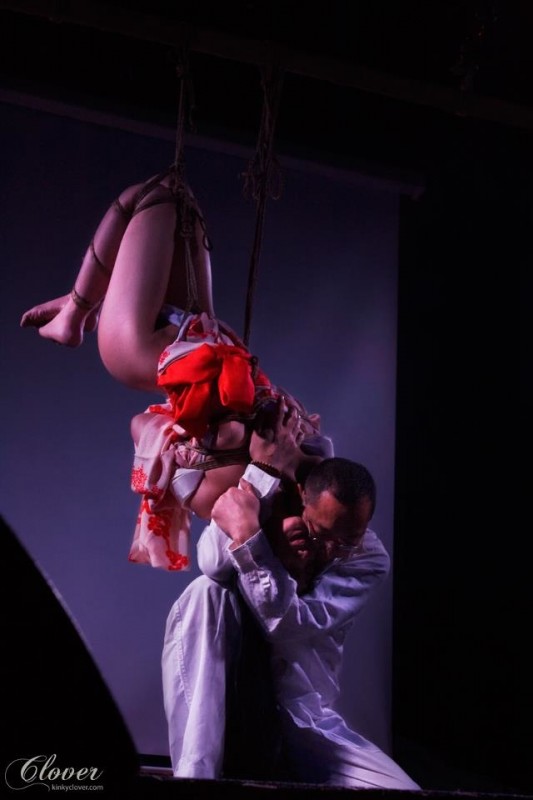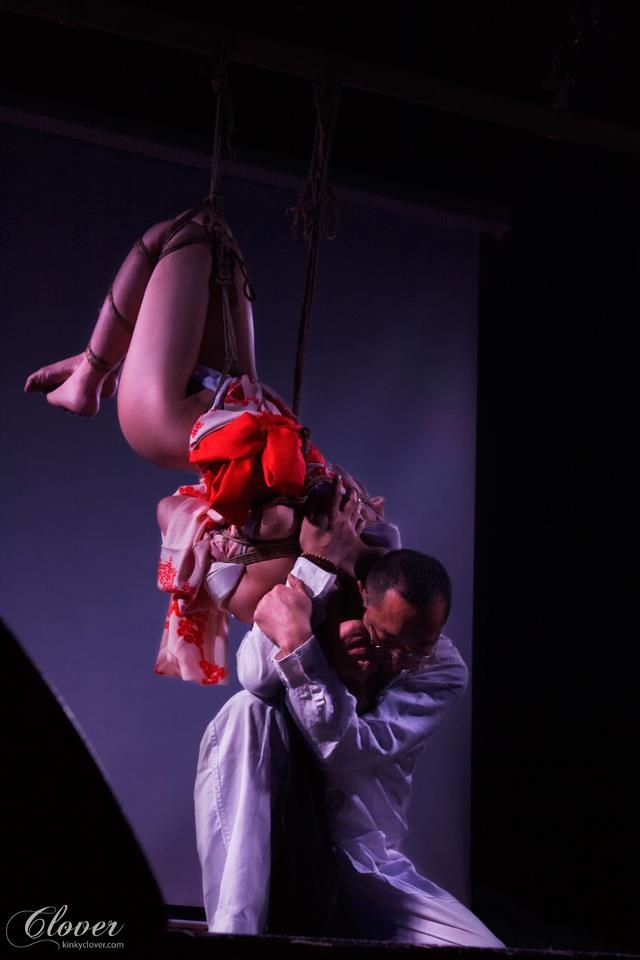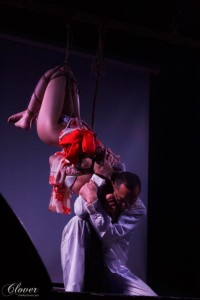[:zh]「原來我不曾懂繩縛。」
與歐洲朋友們見面總是給我這樣的衝擊。「原來我不曾懂繩縛,」去年在倫敦聽了 Hedwig 的課之後我這麼對自己說。今年在莫斯科,我又對自己講了同樣的話。一方面體認到自己的不足而難過,又因知道還有多少可學而充滿了期待。
莫斯科「Moscow Knot 國際繩縛派對」由 Vlada, Falco, 和 Torquemada 主辦,是他們第一次辦國際活動。Vlada 和 Falco 也參加了去年的倫敦緊縛美之祭,也許因而想在莫斯科也辦個繩縛節慶。據說核心工作人員大約只有五、六位,但參與的俄國表演者和邀請的外國表演者各有 8 組,為期三天,晚上表演,白天有開課與訪談。接待我們的工作人員 Scarlett 說:「Vlada 想辦,而凡是 Valda 想做的 Falco 就會去做。」憑著一股衝勁,辦了這場總支出達新台幣七十萬以上的大活動(盧布幣值和新台幣大約相等)。
今年最受矚目的無疑是日本繩師奈加あきら。師承濡木痴夢男的奈加保留了最古樸的繩縛風格。他不用鉤環,而用繩當場製作懸吊點;不接繩,每用完一整條繩便另找地方重新開始。但這樣的繩縛風格該如何欣賞?Riccardo Wildties 的責め縄課程恰好可作為奈加流繩縛的導讀,使人了解,看似「不使用」某些技術的選擇其實和奈加氏的繩縛美學環環相扣。在竹子上現作懸吊點,不受定點的限制;接繩不得不一氣呵成,不接繩則讓繩模、奈加、和觀眾都有了停頓、沈澱的機會。
奈加氏的表演節奏緩慢而凝重。他會將一根繩用完,退後,觀察繩模,看著她痛苦掙扎,並給她適應的時間。然後再加上一根繩,把繩模推向下一個更艱難的姿勢。彷彿按著步調緩慢加重、慢慢激出腦內啡的一場鞭打儀式 — 原來繩和鞭的道理是相通的。痛有許多種,講鞭打時我們不也這麼說嗎?Riccardo 示範時猛然捏了繩模 Redsabbath 一下,她叫了一聲。「這是痛。但這不美,這不是我們要的。我們要看的是『beautiful suffering — 美麗的受苦』。」這是他心目中日式繩縛的精要。然後 Riccardo 綑綁 Redsabbath。隨著繩子一根根加上,我們看著 Redsabbath 逐漸恍惚、喘息,扭曲而綻放得像一朵花。「現在,這很美。」Riccardo 說。
就在那一刻,我發現我不曾懂繩縛。
奈加あきら第一晚的表演從技術上再簡單不過。吊起,稍稍扭轉一下姿勢,然後放下。但這以足以讓觀眾們一個個看得流淚。排在他之後上場的 Riccardo 得趕忙阻止 Redsabbath:「不要哭!妝會糊掉的!」Wykd Dave 看完表演之後激動莫名,無法停止地和我一直說話。「那麼簡單,因此而那麼美。這需要多大的勇氣和自信?如果我再綁十年,不,如果十年之後我還能綁,我能綁得那麼好嗎?」
我則想,台灣在幾年後才能準備好,看得懂這種表演?
日本繩師來台,夜店老闆要求「先綁好再上去,上去直接打就好了」不過是幾年前的事。我們現在進步了多少?
欣賞的能力也是要學習的。觀眾對技藝的鑑賞能力,往往和當地的實踐水準密切相關。日本作為日式繩縛的發源,自是有深厚傳統。有趣的是,日式、學徒式的學習方式是觀察、模仿、「偷」老師的技巧,相當緩慢,也少有系統性的教學。對大家的提問,奈加往往只回答「只是因為心情」。西方 BDSM 圈本有著述、教學的傳統,近年來對日式繩縛做了許多細緻的詮釋,化為可以傳授的課程。這次在莫斯科,Wykd Dave 與 Clover 教「一繩」與著地吊縛,Jack 與 Zahara 從人體結構、關節技、講到兩人互動,Riccardo 與 Redsabbath 教責め縄,Stefano 教繩縛與性愛,都是專門的進階課程,分門別類的細緻度超過我在日本所見。也難怪歐洲這幾年進步神速。而俄羅斯的平均水準不及歐洲他國,但仍有令人驚艷的幾組表演者,並有能力出得了八組表演。表演同時,隔壁的場地也有人不斷練習。這些人日後都還會進步。
台灣呢?作為地理距離、文化都與日本相對接近,語言障礙也較小的鄰國,台灣的發展為何仍相對遲緩?
如果把他們帶來台灣,能不能給我們一些衝擊,撒下一些種子?Vlada 辦這場活動時,也抱著一樣的想法嗎?我和 Vlada 說,她做了一件很了不起的事。這對本地的繩縛圈子一定很有幫助。她只淡淡地回:「我想辦,因為我喜歡。」十足的俄羅斯女王架式。
那晚,Dave 一口氣講了很多。談起他的「一繩」。這套想法教給了 Hedwig, 我聽了一次,帶回台灣成了我們教學課中的「情趣繩縛」。「因為只用一根繩,因為不打結、不扣繩,所以你才自由了。所以你可以專注在你的伴侶,而不是繩上。」他從繩、說到藝術、說到人生歷練。最後他道歉:「對不起,我講太多了。」
幾個月前,Stefano 才為了同一個理由和我道歉,「對不起,說到繩子,我就很激動。」當時他們有著一樣的眼神,洋溢著熱情與愛的眼神。
我的回答也一樣:道謝,因為他們願意對我說這麼多。
我好想把他們帶來台灣。
同步刊載於皮繩愉虐邦。[:en]”How little I knew about shibari.”
So I said to myself when I listened to Hedwig‘s course last year in London. So I said to myself again this year. Every time I meet my European friends, I am saddened by realising how little I knew, but also thrilled by how much there is to learn.
Moscow Knot: International Bondage Party is organised by Vlada, Falco, and Torquemada. A three-day festival with 8 pairs of local performers and 8 pairs of foreign performers, workshop, interview, and party, is a huge event, especially for a team who organises an international event for the first time.
The spotlight of the event is undoubtedly on Naka Akira. Under influence of Nureki Chimuo, he practices, in my opinion, one of the older style of shibari. He uses no carabiners, and instead spontaneously ties attachment points on a bamboo pole. He does not connect ropes, but always start from a new point after finishing using one rope. But how do we learn to understand and appreciate such a style?

Naka Akira and Shizuki Iroha in Moscow Knot 2013. Photo by Clover.
The seme-nawa course offered by Riccardo Wildties, a big fan of Naka-san, turned out to be a fitting introduction — the choices of not using certain techniques are in fact closely tied with the aesthetics of Naka-style. Tying to a bamboo allows for flexibility, while not connecting ropes allows the model, the rigger, and the audience, to pause between breaks.
Naka-san’s performances are usually slow but intense. He would completely apply one rope to the model’s body, step back, observe the model in agony, before applying the next rope to push her a bit further. In my opinion, it is like a spanking session that starts in a slow pace and gradually intensifies to stimulate endorphin — it turn out that ropes and whips do share something in common. Aren’t we used to say when we teach spanking that there is not one but many kinds of “pain”? In the course, Riccardo pinched Redsabbath out of blue and “ouch!” she shouted. Riccardo commented: “It hurts, but it’s not beautiful. What we want is ‘beautiful suffering.'” He then started tying Redsabbath, one ope after another, as we watch her gradually suspended and bloomed like a flower. “Now, this is beautiful.” Riccardo said.
That’s the moment when I again said to myself: how little did I know about shibari.
Naka-san’s performance appears to be technically as simple as a performance can be. Yet it is so touching that the audience could not help sobbing. Dave was very moved by the performance. “How much confidence does it take to do something so simple, and yet so beautiful? If I keep tying for ten more years, no, if I can still tie after ten years, can I tie so well?”
Meanwhile, I was thinking “how many years is it going to take before people in Taiwan could appreciate this show?” It wasn’t long ago when the Japanese nawashi we invited was asked by the club owner to “tie the girl off stage and start right from the whipping.” How much have we improved since then?
Appreciation of art is an acquired ability. The ability of the a crowd to appreciate art is in proportion to the competence of their local artists. We have seen the west improving so quickly in the past decade, and I believe that a major contributing factor is due to the tradition of sharing and teaching in the western BDSM circle. Take the classes in Moscow Knot: Dave and Clover on ichinawa and partial suspension, Jack and Zahara on connection, body control, and intention, Riccardo and Redsabbath on seme-nawa, Stefano on suspension and sex, and Xanoo on hojojutsu… all these courses are more focused and specialised than any I have seen in Japan.
Russian audiences are enthusiastic to learn. There are often some people practising in the room next to the stage. They will improve.
What about Taiwan?
If we bring some of these excellent performers and lecturers to Taiwan, can they impact the local scene, and sow some seed that may bloom later?
Was it what Vlada had in mind when she organised the event? I told her that she did a great thing that will be beneficial to the local community. Vlada calmly replied, “I did it, simply because I like it.”
* * *
That night Dave talked to me a lot. From shibari, to art, and to life. Then he paused, “I’m sorry. I am talking too much.”
Months ago Stefano made the same apology to me after talking about ropes. I saw the same thing in their eyes: the kind of passion in the eyes of those who talking about something they deeply love. My response was the same: I thanked them, for teaching me so much.
Each time I talked to Dave, I feel enlightened. And each time I saw Jack and Zahara on stage, I feel joy. Since the first time I saw them on stage, they have always surprised me with different ways they can perform, yet show the same love and intimacy. With their permission, I taped their last performance in Moscow Knot to bring back to Taiwan, which can be very good tutorial.
I am happy among these friends, who share the same love and passion. How lucky I am to be with these wonderful people.
Also published on 皮繩愉虐邦.[:ja][:]


留言
“看心情”这是所有匠人在一个阶段情不自禁的告白。我不认为奈加在搪塞。